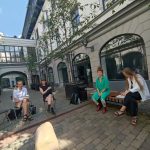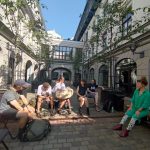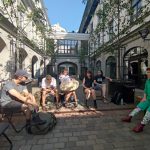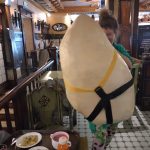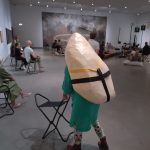Material Agency and Artwork as Performer. Artist Talk
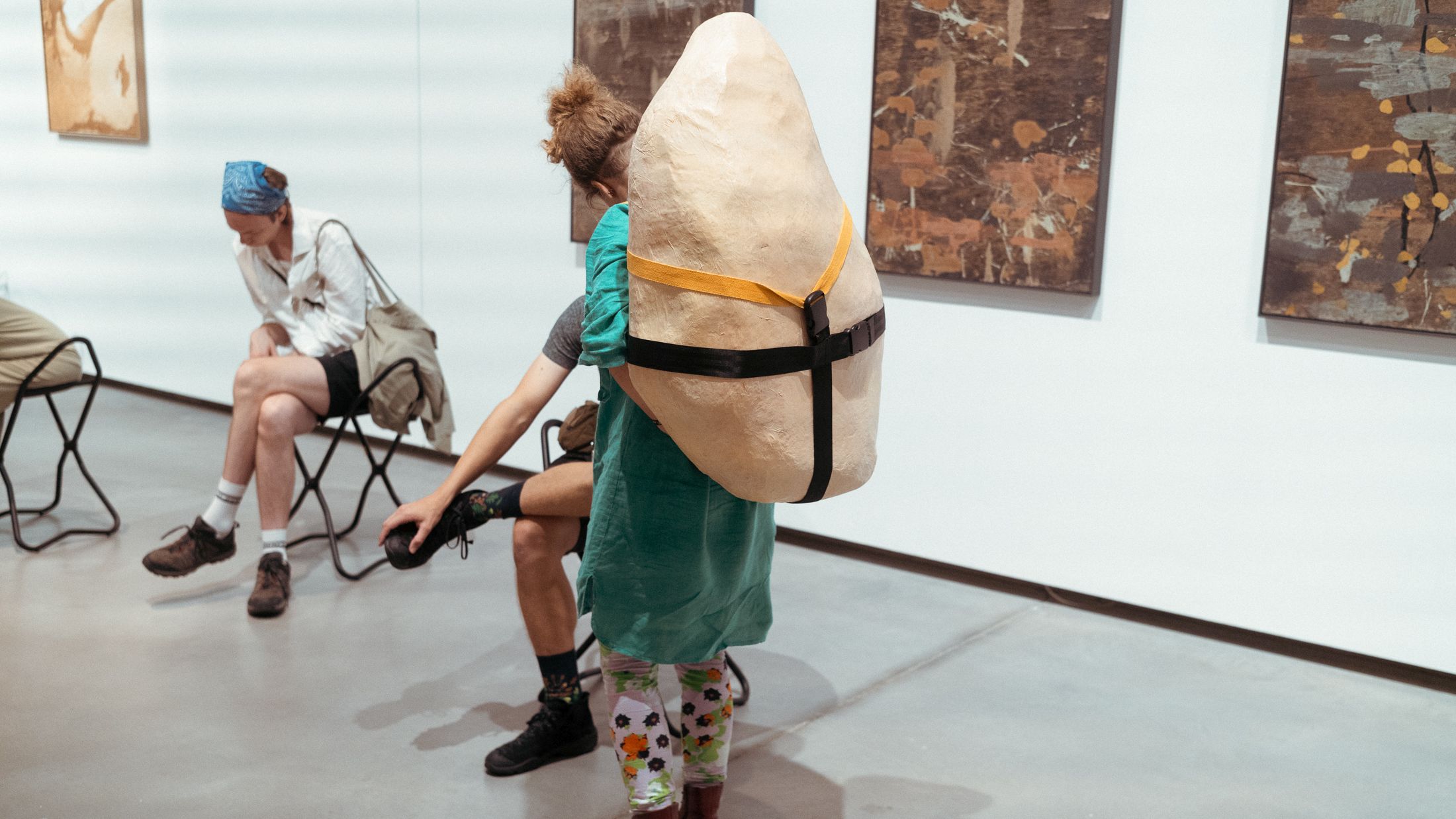
In conversation with Latvian artist and sculptor Gundega Evelone, the Finnish artist Laura Puska introduces the project URGENT – Residency for Artworks that serves as a platform to ponder upon material agency.
Gundega Evelone: Maybe you can tell us a little bit about yourself, and how you met blob?
Laura Puska: I’m Laura Puska, and I’m here today to share with you my work “URGENT – Residency for Artworks”. It’s a performance-based piece where I invite artworks from other artists to live with me. I carry them around and observe how the objects perform. Last year, I worked with three different objects from Eva Spierenburg, Niina Tervo and Sijben Rosa. Today I’m here with blob, the sculpture by Eva Spierenburg. “URGENT” is an ongoing work that cherishes the process, it is a platform for exchange, research, and thinking together. I invite you to encounter blob, like you are, as a physical being in the world. So feel free to touch it, lift it, or sit next to it during the talk and after it. Just a note that blob is sensitive to liquids and sharp objects.
G.E.: Like a human being!
L.P.: A being, but no drinks, no piercings, no alcohol. Otherwise, it’s a very durable, charming fellow.
G.E.: And how long is your relationship with him? Or is it she or he or they?
L.P.: I use “it”. It might be because I’m Finnish and in our language we don’t have genders for words, so I tend to use “it”. It’s an issue that actually comes up with all the objects in some conversations. Blob is my permanent resident and co-worker. I did a pilot in 2020, and since then, blob has been living with me. Eva, the creator of blob, is busy with new work and doesn’t want it back. She says, “It’s too busy in my studio – don’t bring it back!” So we are basically living together forever, and therefore the collaboration between me and Eva is ongoing.
G.E.: Forever, wow. That’s quite a long period. But how do you characterize it? Is it your pet, or is it like another non-human being, on the same level of consciousness as you, but only silent? Or is it just an item? Do you have some kind of mental relationship with it?
L.P.: I think blob is very close to a perfect sculpture, and I really trust it. I would even say that we have a close, rather intimate relationship, built over months of working and performing together. Eva sometimes says she doesn’t feel it’s her object anymore – it’s distancing itself from her. Or perhaps it has found its place in between our practices. I try to remind myself and others that it’s still just an object – a block of matter. I don’t intentionally try to humanize it, but that can happen easily. I think it’s something we as humans do. In this piece, I’m basically asking you to encounter and care for an object, and we often approach care situations with empathy and assimilation. Having an anthropomorphic approach to an object may indicate some sort of care – or intention to build a relationship.
G.E.: Yes, very quickly we start to have feelings for objects, for amulets, because we personify them with another person who is already there for us.
L.P.: When I carry it, we sort of unite; we share a body when I use my hands and legs to move the sculpture. Otherwise, I do think that we are separate units – we have our own lives. Weŗe not living in symbiosis. In the beginning, when I started working with it, I was really confused. I live in Ghent, in Belgium, and when I went into the city and ran into friends or colleagues, the first thing they asked me was how blob was doing. This happened even when the sculpture wasn’t with me. It took me some time to get my head around it. I thought, “I left it on the sofa, what is the question?”. It developed this character even through its absence, which is fascinating.
G.E.: Maybe you can tell me more – how did you get this idea? What was your way of starting this project?
L.P.: The work stems from a bigger question I’ve been quite occupied with for the past few years. It has to do with adapting artistic practices – how I, or artists in general, adapt our professional practices to the current state of the world, with economic and social crises. I’m thinking of this as a crisis of production. I have a background in crafts; I was originally educated as a glassblower. It’s a job based on producing new, handmade objects – which means expensive objects compared to mass-produced objects. Producing new things feels absurd when we live in a world already full of objects. Do we need more of them, or what do we do with them? What kind of relationship do we have with objects? If we think of functional objects, like scissors – we call them scissors when they cut. When they don’t, they’re a waste. Trash. It’s very narrow, what we allow for objects and materials. And surely, the same can be asked about humans – if we allow anything more for people when it comes to disabilities or marginalized groups.
G.E.: And then you had the idea about this residency. As I understand it, there were several other residents with you, and one of them had a, how to say, not-so-lucky fate. Can you tell me about it?
L.P.: Yes, there were three sculptures by three artists. Originally, the idea was to keep them separate – four months living with each object. Last year, I was invited to a residency at Kunsthal Gent, so I thought it would be nice to have them all together. The artists were fine with a change of schedule, and we ended up having this family of sculptures. Yesterday I realized I still can’t talk about blob without mentioning the other objects. We are a sculptural family and it’s been magical to follow how differently they behave and how the objects relate to each other. Blob is a very social object – it sparks interactions easily. Cars might stop in the middle of traffic to ask me, “What are you carrying?”. Then, the glass object by Niina Tervo – eight kilos of hand-blown glass – was a little bit like a moth or something. People were very reserved around it, and I had a hard time because I felt the sculpture didn’t speak, didn’t resonate, or I didn’t know how to activate it. After a while, I made a leash for it and started dragging it around.
G.E.: It made some sound?
L.P.: Yes, and then it was screaming! I realized that this object really rejected the human language – that it only communicated through contact with other materials, in its own material way. But indeed, that piece unfortunately broke down in an accident during transport. I had to return it to Niina in pieces, which was – and still is – heartbreaking. But we knew there was a risk. I collected every little piece. It was really shattered. All the material is still there…
G.E.: It has physical presence, but in another form.
L.P.: Exactly. Before I start working with a sculpture, we go through the do’s and don’ts with the artist. Accidents are surely different, unwanted things that can happen. But the residency isn’t for every kind of sculpture or artist. It’s quite an unconventional approach, dragging someone’s sculpture on asphalt. We talked about this with Niina – that it’s sculpting through performance. We both found it interesting to blur the line between sculpting and performing. But through the accident, the sculpture was really re-sculpted when it broke. Now it’s returned to Niina in a transformed form, back in its sculpting process.
Then there’s the third piece by Sijben – a huge, black, junky, heavy piece of work. It was a physical challenge for me. Sijben lives in Amsterdam, and I try to travel by land to pick and return the works. I was taking the train and I didn’t have wheels at that point. Later, I had three different wheel systems for that sculpture. There were train issues that complicated the trip, and I injured my back. I went to a doctor who asked me what I do for a living. I said, “I carry objects around.” He gave me a sick leave and told me not to carry objects anymore. All three sculptures were different and had their own emphases – social, material, or bodily. It’s been truly eye-opening to look at the role of objects in society through working and performing with these sculptures.
G.E.: You mentioned some reactions from spectators. How do people usually react to blob? Do they want to touch it? Or do they keep their distance?
L.P.: It is still difficult to make people hold something. Whenever I move around with an object, there’s this responsibility toward the maker of the object. I’m a caregiver. During the performance period, I get nightmares about breaking the sculptures. At one point, I had a nightmare of blob being pierced like Frida Kahlo. Eva made drawings of it [laughs]. Since then, she keeps asking me: “Do you have more nightmares, so I can make more drawings?” But jokes aside, the responsibility for care is always in the back of my mind. Of course, with the artists, we talked about the risks. With Nina, we even discussed getting insurance for the glass piece, but no company insures art that you carry around. We’re supposed to look at art from a distance, and that art should stand still.
G.E.: How did the name ‘blob’ come about? Was that your idea or Eva’s?
L.P.: It was Eva’s idea. With this sculpture, we could actually even ask if it is an art piece. Eva worked on it for a long time. It was trying to find its way into her installations and sculptural work, but it didn’t. So when I visited her studio, she said: “Oh, this is kind of an extra one. Take this one!”
G.E.: Maybe you can tell me – do you have some special place for it in your apartment? Because it’s an object that creates some kind of landscape. Maybe it has its own, I don’t know, sofa or pedestal?
L.P.: Well, I recently moved apartments, but in the previous apartment, when it arrived, we really had to fight over the sofa. A typical scenario would be: I’m on the sofa, then I leave, put blob there – and whenever I wanted to return, I had to move it first. So it really complicated my life. And then when the three objects were all in the house together, it was interesting to see how they started to group together. They weren’t hanging out on the sofa anymore – they took over the floor. I felt like an outsider – a human among these objects. It was nice to see how the dynamics changed when the objects were the majority.
G.E.: This seems to me like a very durational, psychological process. It’s developing, you are developing your feelings for it. Do you have any idea how this will end? How will it result?
L.P.: I don’t know yet. I’m not talking to blob every day. But I do notice that when guests or friends come over, they always go and talk to blob – or at least say hi and bye. Sometimes I don’t even remember that I have this object around. So it’s not always in an active stage – sometimes it has its own stuff.
G.E.: And sometimes you just start to work with it and move it?
L.P.: Yeah, I work with a performance schedule to keep the focus and to plan when I leave the house with an object, because moving gets complicated and needs preparation. Sometimes it’s more spontaneous – we just start moving around and playing, like making still lifes in the living room.
G.E.: How about your physical state? You are bringing it everywhere with you, and earlier you said you even had back problems. How is your body responding to it? Have your feelings changed over time?
L.P.: It is a challenging piece physically. If you touch and hold the sculpture, you’ll notice it’s really not straight or symmetrical from any angle. When I was making the clothes – we have rain gear and a carrying harness – it was difficult because of its organic form. I feel it when I’m carrying it, too. It changes my posture and proportions. And then there’s the fact that it makes me visible when I’m walking around with it. I recently saw – or rather, my neighbor saw me on the street. Suddenly I heard a knock on blob from behind. It was puzzling – like I’m a snail with a back door.
G.E.: They find ways to interact by themselves.
L.P.: Yes, exactly. That’s the thing. Life with a sculpture can also be very subtle. I don’t want to force it to perform. Rather, I try to practice sensitivity towards noticing how and when it resonates; what kind of encounters it invites, what conversations it leads me to have, and where it takes me. I really consider myself as the legs only. The sculpture is the voice. It’s through its material and form that encounters happen.
Back


